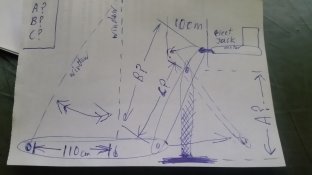Hi all.
I know the principal of how it works in my head,
I just cant remember the math to work it out.
Basicly im wanting to open a window 110cm, with a 10cm electric bed (screw/piston) motor (rated at 220kg)
I also see this idea being used at Halloween to make small props big etc.
Any Formula's on how i would work out the Values for A,B,C ? would be great (correct answers would be even better)

I know the principal of how it works in my head,
I just cant remember the math to work it out.
Basicly im wanting to open a window 110cm, with a 10cm electric bed (screw/piston) motor (rated at 220kg)
I also see this idea being used at Halloween to make small props big etc.
Any Formula's on how i would work out the Values for A,B,C ? would be great (correct answers would be even better)


